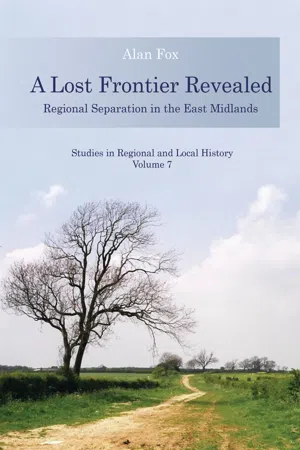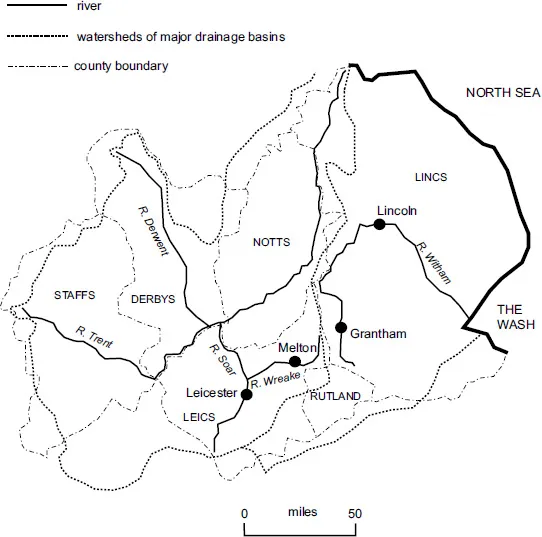
- 320 pages
- English
- ePUB (mobile friendly)
- Available on iOS & Android
eBook - ePub
About this book
Seeking to draw new conclusions about settlement distributions and population densities, patterns of wealth, underprivileged assistance, and land usage, this reference uses multiple criteria to subdivide England into regions. This unusual and probing study establishes the presence of an informal cultural frontier between two proposed societies, which would lie astride the Leicestershire–Lincolnshire border, in order to identify cultural differences and divides that are clearly visible in the English countryside. Taking the unique approach of stressing early-modern-period rural landscapes, this examination looks at the enduring social and economic links between the area's population and its landscape.
Frequently asked questions
Yes, you can cancel anytime from the Subscription tab in your account settings on the Perlego website. Your subscription will stay active until the end of your current billing period. Learn how to cancel your subscription.
At the moment all of our mobile-responsive ePub books are available to download via the app. Most of our PDFs are also available to download and we're working on making the final remaining ones downloadable now. Learn more here.
Perlego offers two plans: Essential and Complete
- Essential is ideal for learners and professionals who enjoy exploring a wide range of subjects. Access the Essential Library with 800,000+ trusted titles and best-sellers across business, personal growth, and the humanities. Includes unlimited reading time and Standard Read Aloud voice.
- Complete: Perfect for advanced learners and researchers needing full, unrestricted access. Unlock 1.4M+ books across hundreds of subjects, including academic and specialized titles. The Complete Plan also includes advanced features like Premium Read Aloud and Research Assistant.
We are an online textbook subscription service, where you can get access to an entire online library for less than the price of a single book per month. With over 1 million books across 1000+ topics, we’ve got you covered! Learn more here.
Look out for the read-aloud symbol on your next book to see if you can listen to it. The read-aloud tool reads text aloud for you, highlighting the text as it is being read. You can pause it, speed it up and slow it down. Learn more here.
Yes! You can use the Perlego app on both iOS or Android devices to read anytime, anywhere — even offline. Perfect for commutes or when you’re on the go.
Please note we cannot support devices running on iOS 13 and Android 7 or earlier. Learn more about using the app.
Please note we cannot support devices running on iOS 13 and Android 7 or earlier. Learn more about using the app.
Yes, you can access A Lost Frontier Revealed by Alan Fox in PDF and/or ePUB format, as well as other popular books in History & British History. We have over one million books available in our catalogue for you to explore.
Information
Part 1
Introduction
Chapter 1
The hypothesis
Regional societies
Phythian-Adams has proposed that, in the past, England consisted of a patchwork of ‘regional societies’, which coincided to a large degree with major drainage basins, so that watersheds often acted as frontier zones from at least Anglo-Saxon times into the early modern period, and perhaps more recently.1 These ‘regions’ were of considerable size and to quite a large extent coincided with groups of pre-1974 counties.2
According to Phythian-Adams, local historians have recognised differences at a very restricted level but have not paid sufficient attention to wider regional themes. He suggests that too much research has been concerned with small areas, even single parishes, whereas the way forward should be to look for much larger geographical units as the basis of study. If this is the case then it is important that we can identify the regions of England, although we may need to acknowledge that the patchwork quilt has changed from time to time.
Regional subdivision of England
Today there are several researchers who are using single criteria to divide England into historic regions. A good example is Schurer’s search for regions from a study of surname patterns.3 Another is Roberts and Wrathmell’s Atlas of rural settlement, which uses, primarily, patterns of village morphology to differentiate between regions.4 It is quite clear that the regions produced in these different ways do not match each other very closely. Phythian-Adams has proposed that the use of single measures is misleading and he recommends a more complex set of criteria.5 His method is to concentrate on economic factors, which include land use, land and water transport, the locations of major towns and ports and the extents of their influence. Using this approach, he has subdivided England into a patchwork of fourteen ‘regional societies’ based on provincial economic units, which in turn are usually focused upon ‘primate towns’. Their names are derived from the river basins or adjacent sea areas which are their dominant features. For instance, this book is concerned with the two’regions’, the names of which - Trent and Witham - reflect the river basins in which they lie.

Figure 1.1 Part of the Midlands: proposed regions. Source: Phythian-Adams, Societies, cultures and kinship, p. xvii.
The Trent ‘region’ is largely comprised of the pre-1974 counties of Leicestershire, Nottinghamshire, Derbyshire and Staffordshire, while the Witham ‘region’ consists of Lincolnshire and Rutland (Figure 1.1). The focus here is on the proposed frontier between these two ‘regions’: that is, the watershed area between the Trent and Witham drainage basins. To a large extent this is also the boundary between the counties of Leicestershire and Lincolnshire.
If there were regional societies in the past one might expect the people, or at least some of them, to have had a sense of belonging or attachment to them. There can be no doubt that individuals had a strong sense of belonging to small geographical areas and their inhabitants, but did any comparable sense of attachment apply to larger units?
Belonging
Throughout history every person probably has had a feeling of membership of at least one group of human beings, a sense of identity which Cohen suggests can be experienced by individuals at various levels, forming a hierarchy of belonging.6 At the lowest level one might include the immediate nuclear family, moving up to extended kin and neighbours at the next stage in the hierarchy. At higher levels still are the village or parish, groups or neighbourhoods of parishes, pays, counties, regions, nation states, groups of nation states and the world community. It may be that the term ‘belonging’ should only be applied to the smaller groups and ‘association’ may perhaps be preferable when speaking of larger ones.
This list is based to a large extent on ever-increasing geographical areas but it should be noted that it is not always possible to subsume one particular community neatly within another. For example, a pays, identified by the similar cultural traditions of its residents, may stretch across a county boundary, as in the cases of Exmoor (Devon and Somerset) and the Weald (Sussex and Kent). Furthermore, there are other identifiable communities whose memberships weave through the geographically defined ones previously mentioned. For example, kin and occupational groups, such as farmers, may form attenuated links across the aforementioned hierarchical arrangement.
Despite these difficulties Phythian-Adams postulates a series of overlapping and ever-widening micro-structures which might eventually have coalesced into the macro-structure of national society, and proposes that the identification of the links in the chain should be the way forward in local history.7 Everitt suggests that, rather than concentrating on individual parishes, we should visualise and re-create ‘those entire networks or regional and dynastic connection which extended beyond the limits of the individual community’.8 He gives an example of a neighbourhood of parishes linked together by strong family dynasties, as in the case of the five or six parishes around Kimcote and Gilmorton in south Leicestershire. Mitson’s research in south-west Nottinghamshire finds identifiable neighbourhoods of communities held together by their similar landholding patterns and economies, in which a small number of very influential dynastic families held the key. Lord and Carter found similar common-interest groups of parishes in south-east Surrey and Huntingdonshire respectively.9
At a higher level it may be that there was allegiance to a particular landscape, or pays, which had distinctive land use, economic activities, settlement history, social structure and local customary law.10 It is important to distinguish here the landscape or pays defined by academic historians and geographers from those ‘self-conscious’ areas that were in the minds of the inhabitants.11 The sense of belonging implies that the second meaning is being discussed here, although explanations of patterns are sought by reference to more objectively determined pays and regions. Butlin suggests that England may have consisted basically of many small-scale pays but, in the last four centuries, the pattern has been complicated by the rise of a succession of larger ‘human regions’ such as the county community, the urban hinterland, the occupational region (for example, the Hallamshire region in and around Sheffield), regions of religious influence and so forth.12 In the next chapter the area under discussion is partitioned, using geology and physical geography, into seven ‘landscapes’. It could be argued that some of these subdivisions were sufficiently different from the others to be given the status of pays, as indeed they are in the work of Holly on Domesday Leicestershire.13
It may have been, and perhaps is still, the case that at higher levels in the hierarchy of belonging there were feelings of identity with even larger geographical areas. In the period from the sixteenth to the eighteenth century, according to Butlin and Marshall, there was among the ruling classes a strong sense of belonging to a county, with much inter-marriage among the gentry of each shire.14 Such attachments may have a much longer history and with wider sections of society, for the counties, mostly formed some time before the Norman Conquest, may have been the formal expressions of previously recognised societies with acknowledged cultural differences from their neighbours. Everitt proposes that county towns such as Leicester were often the foci of county identities, increasingly so in the early modern period as transport improved, and he suggests that they provided a meeting point for the traders from the surrounding pays, each with its own developing specialisation.15 He refers to the whole population of Kent as being ‘one organic, hierarchical, paternalistic community’.16 Roberts, in his work on seventeenth-century Devon, finds that many adult males were involved in local administration, which was controlled from above by the county authority and in turn by national government. However, he concludes that, below the level of justice of the peace, lesser men might have worked diligently but had no real power and thus no strong sense of identity with the county. In any case he proposes that most men, even the gentry, were only concerned with ‘parish pump problems’.17 Nevertheless, Carter found that the county boundary between Cambridgeshire and Huntingdonshire was seen as a barrier against the choice of marriage partners between 1580 and 1850.18 In 1841 at Claybrooke in Leicestershire 94 per cent of the population had been born in the county though the parish is adjacent to the county boundary with Warwickshire.19 The subject of the effect of county attachment is returned to in the final chapter.
At the same or an even higher level than the county we come to the concept which concerns us here: that of the region, including the ‘regional society’ as proposed by Phythian-Adams. The term ‘region’ has, of course, been with us for some time and some o...
Table of contents
- Cover
- Previous titles in this series
- Title
- Copyright
- Contents
- List of figures
- List of tables
- General Editor’s preface
- Acknowledgements
- Abbreviations
- Part 1 Introduction
- Part 2 A countryside divided?
- Part 3 Mechanisms of segregation
- Part 4 Conclusion
- Appendix
- Bibliography
- Index